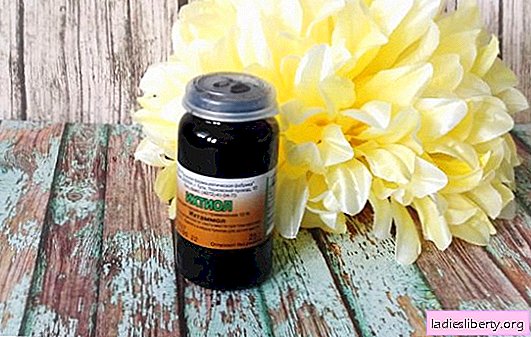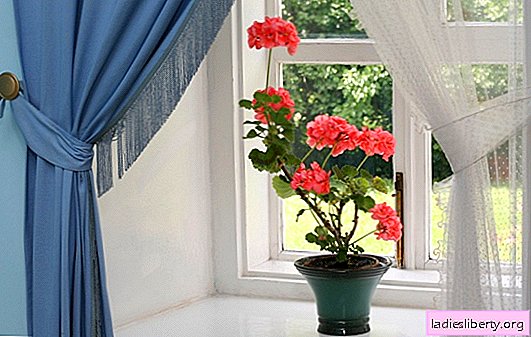
A highly effective remedy does not have to be expensive and advertised, sometimes miraculous cures are demonstrated by budgetary, but time-tested drugs. This is exactly how ichthyol ointment is. What helps ichthyol ointment and how to apply it, read in our article.
Description
Ichthyol ointment is a dark brown substance of a thick consistency with an unusual smell. It owes its appearance and unpleasant aroma to its natural origin. Its main ingredient is ichthyol, obtained by distillation of oil shale from sulfur. He determines the main healing properties of the ointment. Vaseline makes up the fat base, which facilitates its application and rubbing on the skin.
Healing properties
Ichthyol ointment has a large number of healing properties:
• anti-inflammatory;
• antiseptic;
• disinfectant;
• keratoplastic;
• local anesthetic;
• regenerative;
• antipruritic;
• improving regional blood circulation.
On the surface of the skin, ichthyol effectively fights against gram-positive flora (streptococci, staphylococci), yeast.
Due to its keratoplastic properties, ichthyol ointment regulates the keratinization of erysipelas, making it more elastic and softer, peeling is eliminated, and skin cell metabolism is activated.
Ichthyol ointment causes slight irritation of the nerve endings of the skin or mucosa, which leads to reflex narrowing of blood vessels and a decrease in the sensitivity of pain receptors. The analgesic effect at the place of application occurs within a few hours. Acting in the outer layers of the skin, it blocks inflammation, relieves redness, swelling, itching, and reduces fluid secretion. Outwardly, it looks like pulling pus from the deep layers of the skin, eliminating suppuration and accelerating healing, therefore the ichthyol is popular with cosmetologists for treating subcutaneous acne and for preventing their formation after deep cleansing of the skin.
Indications for use
Ichthyol ointment is widely used in many inflammatory diseases in dermatology, surgery and gynecology.
Topically, the drug is applied to the skin with:
• burns of the first degree;
• frostbite;
• eczema;
• psoriasis;
• rosacea;
• acne;
• arthritis;
• neuralgia caused by trauma or inflammation of the nerve;
• bruises;
• skin lesions with lupus erythematosus;
• rotten splinters;
• skin irritations as a result of a nettle burn or other plants;
• ingrown toenail;
• insect bites.
Ichthyol ointment helps with infectious and inflammatory skin diseases, which has found its application in the treatment of:
• erysipelas;
• hydradenitis;
• folliculitis;
• furunculosis;
• microsporia and trichophytosis (purulent process);
• carbunculosis;
• sycosis.
With diseases of the internal organs of the small pelvis, such as:
• salpingitis;
• oophoritis;
• prostatitis;
• endometritis;
• parameter;
• hemorrhoids;
• anal fissures.
The use of ichthyol ointment
Before applying ichthyol ointment, the affected area should first be cleaned with an alcohol solution, calendula or chamomile tincture. Then finely spread the ointment over the affected area of the skin. To enhance effectiveness, you can rub the ointment in a circular motion with arthritis, neuralgia, eczema, psoriasis.
In order not to accidentally wipe the ointment with clothing, the place of application should be covered with a gauze cloth and bandaged or glued with a band-aid. The dressing changes no less than after 8 hours.
Ichthyol ointment is available in two forms: 10% of the active ingredient in the ointment and 20%.
The higher the concentration of ichthyol, the more pronounced its pharmacological properties. The stronger the inflammation, the higher the concentration of ichthyol should be chosen. So, 20% ointment is effective for hydradenitis, furunculosis, carbunculosis. While with eczema, acne, it can dry the skin, causing excessive flaking. In these cases, it is better to use a 10% ointment.
With burns, ichthyol ointment helps when there is only redness, without a blister and the area of the affected surface does not exceed 10 cm2.
Please note that ichthyol ointment is not used in the presence of open wound surfaces of the skin and mucous membranes (cuts, abrasions, wounds, ulcers). Due to its irritating properties, it can aggravate pain and aggravate inflammation.
I especially want to highlight the use of this medication in the treatment of acne and acne.
Ichthyol ointment helps to "mature" deep subcutaneous acne, and after the design of an abscess, it removes pus and accelerates wound healing. The pain process and redness pass in the shortest possible time, which is important when the pimple is on the face, and it is not possible to hide it with cosmetics.
Another nice point in cosmetology is the ability of ichthyol ointment to dissolve comedones or, quite simply, black dots. The medication softens and removes the cork in its shallow location, smoothing the skin and tightening pores. To do this, ointment must be applied pointwise to a pimple or problem area. Make sure that the ointment does not get into your eyes! After a few hours, remove excess drug with a napkin and wash with warm water. It is better to do this in the evening, when you are no longer planning to leave the house. The dark look of the ointment on the face looks unaesthetic, in addition, its unpleasant smell can confuse others, although it disappears quite quickly.
To treat inflammation of the internal organs, the tampon is covered with ointment and inserted into the rectum or vagina to a depth of 2-4 cm. For such cases, it is possible to use suppositories with ichthyol.
Ichthyol ointment in rare cases can cause intolerance, which looks like allergic dermatitis (redness, itching, burning sensation). Therefore, if you have previously had hypersensitivity to other medicines, for the first time, apply the ointment with caution, pointwise.
The use of ointments in pregnant and breast-feeding women is of concern. But are they true? Ichthyol ointment absolutely does not penetrate through the skin and is not absorbed into the bloodstream, therefore it is safe for both the fetus and the born baby.
Packing option: how to choose?
They sell ointment in dark glass jars with a tight-fitting polyethylene lid or in aluminum tubes. The latter option is more economical in consumption, since it is convenient to squeeze the required amount of the drug. In addition, in the tube, the ointment does not interact with atmospheric oxygen, does not oxidize, and therefore its effectiveness will not decrease during storage after opening. Therefore, if a significant consumption of ointment is meant for processing large surfaces of the skin, choose a glass jar. If the drug will be applied pointwise in episodic cases, for example, to treat acne, buy an ointment in a tube.
Currently, ichthyol ointment has been unreasonably forgotten by doctors, but its availability and effectiveness have helped it take a strong place in traditional medicine. This drug can definitely be recommended to everyone for a home pharmacy.











